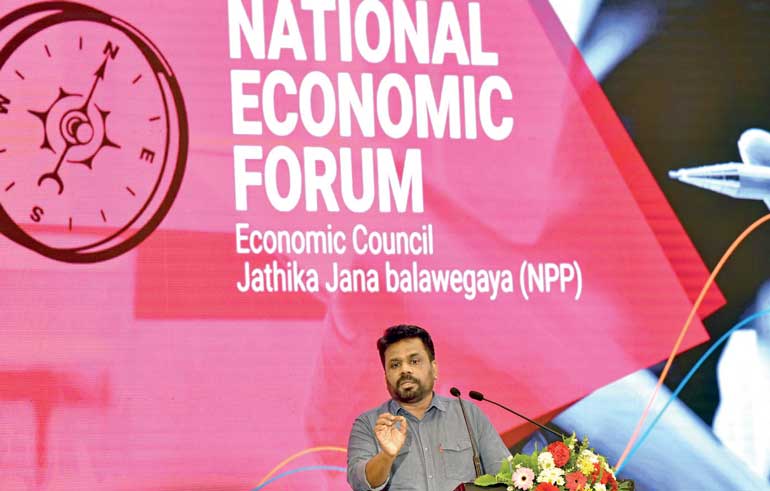Monday Apr 07, 2025
Monday Apr 07, 2025
Tuesday, 7 February 2023 01:08 - - {{hitsCtrl.values.hits}}

Contrary to the assumption underlying Dissanayake’s self-sufficiency argument, renewable energy requires significant, upfront expenditure of dollars

Politicians and their advisors tend to come up with policy positions making little effort to study the domains they are making policies for. An example is the Glyphosate ban implemented and withdrawn during the Sirisena presidency. Ven. Athuraliye Rathana, MP, provided the advice, but had not made the effort to identify acceptable substitutes. Unapproved chemicals worse than Glyphosate were used, leading to problems in the Japanese market for Ceylon Tea.
No foreign investment
The latest member of the Rathana school of policy formulation is the leader of the JVP and the principal voice of the NPP, Anura Kumara Dissanayake. After criticising the way policies were formulated in the past (throwing in a reference to Gnanakka for good measure), he announced at the Galadari that no foreign investors will be allowed to participate in the generation of electricity based on wind. If foreign investors are involved, their profits will flow out of the country in dollars; that is no different from paying dollars to import fossil fuel to generate electricity as we do now, Dissanayake said.
Technological and economic realities
Upon hearing this pronouncement, I sought the observations of Mervyn de Silva, an energy expert who formulated proposals for the earliest wind-based plants in the Kalpitiya area. They are given in the following three paragraphs.
“Wind power plants were introduced around 2006, the first large plant being from Senok with 1.2 MW Suzlon turbines for a 10 MW facility. These plants are now little old but continue to generate about 2.8 GWhrs per MW. Small plants of 600 KW are also operating successfully. Later additions were 2 MW plants and 1.5 MW plants with similar output ratios. Erection of towers for these large plants requires considerable technology knowhow and is done mostly by Indian companies. Equipment is sourced from Indian manufacturers of European origin technology. With an ADB loan of USD 145 million, the CEB commissioned a successful 100 MW wind-power farm in Mannar, using imported Vestas 3.3 MW turbines erected by Indian crews. It should be noted that Vestas gave a special price to CEB to break into the Sri Lankan market. The cost would normally be in the region of USD 160 million. It is possible to generate around 4 GWhrs per MW due to the energetic wind regime in Mannar.
“The power generated by a wind turbine is primarily proportional to the sweep area and the wind speed. It also varies with temperature, wind density and height from the ground. There are two peaks in the Sri Lankan wind regime, with the highest peak associated with the Southwest Monsoon, and the other during the Northeast Monsoon. Efficient generation requires big turbines and massive blades.
“These big turbines, rotor blades, and towers are manufactured overseas. The local costs are only for labor in civil works. The Mannar CEB plant needed a new substation at Nadukudah and transmission lines to Medawachchiya and Vavuniya. The domestic demand is insufficient to justify manufacturing facilities though we have a wind potential of more than 3000 MW. The demand for the equipment necessary for the utilisation of our wind potential must be large to get economic advantages in procurement and production scheduling. Local assembly of heavy cranes of 600 MT and more may be feasible if the required investments are made. The business case would depend on how much of the wind potential is to be tapped and if the South Indian market is also addressable. If it is only to meet domestic demand, there may be no business case.”
Wind is an intermittent source of electricity. Until low-cost batteries or other ways of storing electricity are in place, a national system can absorb only a limited amount of power generated from wind. One workaround is the interconnection of grids, as is common in Europe. In the resulting larger system, more intermittent power can be absorbed without destabilising the grid. In the case of Sri Lanka, this means interconnecting with the much larger South Indian grid using a High Voltage Direct Current (HVDC) cable across the water. This too will use mostly foreign-sourced material.
Dollar loans or investments?
So, contrary to the assumption underlying Dissanayake’s self-sufficiency argument, renewable energy requires significant, upfront expenditure of dollars. The wind does blow year in and year out but does not magically generate electricity. Turbines, blades and transmission equipment have to be installed, maintained, and periodically replaced. These activities require investment in dollars. If foreign participation in renewable energy production is prohibited by a JVP government, the government or the local businesses that are permitted to participate will still have to source those dollars in the form of loans. And these days, as everyone knows, loans are hard to come by.
If investment is allowed, and investors are allowed to serve both the Indian and Sri Lankan demand, business risks can be shared. The governments will have to work out the investment in the HVDC cable and the terms and conditions of the cross-border electricity transactions. Given the massive growth in generation in South India, it is not possible to assume that there will be demand for Sri Lankan electricity unless the price points are attractive enough. Investment means that dollars will come in up front when most needed and earnings will be taken out over the years. In addition, replacing fossil fuel has many advantages. Our industries may be able to gain credit for green energy use. The upfront investment will avoid the recurrent and rising costs of importing fossil fuel for electricity generation.
Renewable energy has many advantages. But it is foolish to imagine that no foreign exchange is involved just because the wind blows over our land. Before those seeking to rule this country pontificate on policy, they should take the trouble to understand what is involved in efficiently producing electricity at a price and in a form appropriate for a modern energy system. Ideology cannot substitute for a correct understanding of technological and economic realities.
Discover Kapruka, the leading online shopping platform in Sri Lanka, where you can conveniently send Gifts and Flowers to your loved ones for any event including Valentine ’s Day. Explore a wide range of popular Shopping Categories on Kapruka, including Toys, Groceries, Electronics, Birthday Cakes, Fruits, Chocolates, Flower Bouquets, Clothing, Watches, Lingerie, Gift Sets and Jewellery. Also if you’re interested in selling with Kapruka, Partner Central by Kapruka is the best solution to start with. Moreover, through Kapruka Global Shop, you can also enjoy the convenience of purchasing products from renowned platforms like Amazon and eBay and have them delivered to Sri Lanka.
Discover Kapruka, the leading online shopping platform in Sri Lanka, where you can conveniently send Gifts and Flowers to your loved ones for any event including Valentine ’s Day. Explore a wide range of popular Shopping Categories on Kapruka, including Toys, Groceries, Electronics, Birthday Cakes, Fruits, Chocolates, Flower Bouquets, Clothing, Watches, Lingerie, Gift Sets and Jewellery. Also if you’re interested in selling with Kapruka, Partner Central by Kapruka is the best solution to start with. Moreover, through Kapruka Global Shop, you can also enjoy the convenience of purchasing products from renowned platforms like Amazon and eBay and have them delivered to Sri Lanka.